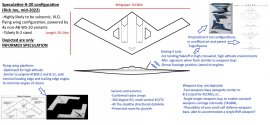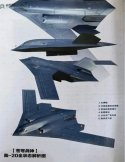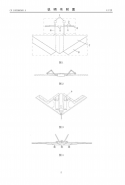With H-20 being on the horizon and likely to emerge in the next couple of years, I want to lay out my hand in terms of what I think a plausible H-20 platform could look like in terms of key remaining unknowns -- namely planform, control surfaces.
Here it is:

Everyone agrees that H-20 will likely be a B-2 sized, VLO, subsonic flying wing powered by four non-AB WS-10 variants at this stage.
Specific flying wing planform:
I believe a B-21 and original ATB configuration is likely the best for stealth as well as high altitude performance. B-2 has a complex trailing edge designed to enable better lower altitude performance (which contemporary stealth bombers will not need), and a "cranked kite" like that of X-47B adds another leading edge angle that add another angle of reflection and another angle that needs to be aligned to mitigate returns (i.e.: overall, less good for RCS mitigation).
Folding V tails:
This one is weird. Some of the depictions of H-20 in art recently (such as on the Modern Weaponry magazine) have shown it with folding V tails, and in a manner that is frankly impractical and not good for stealth either. Having exposed V tails that fold flat but where the gaps are able to be observed from ground based radar is not good at all. Before that, there was a strange patent depicting a flying wing stealth bomber (which I actually partially traced my drawing off) with folding V tails -- but again impractically it is right where the exhausts for the engines are, though in this case they at least folding on the dorsal side of the fuselage so that the ventral fuselage is entirely continuous.
I have depicted some possible V tails in what I think is the only plausible place to have them -- on the dorsal side of the fuselage, lateral to the main engines. When folded, they would be continuous with the rest of the dorsal surface of the fuselage and essentially no less stealthy than if they had an additional opening weapons bay panel door on the top side of the aircraft. Given the altitudes at which these stealth bombers will operate at, whatever minor adverse affect it may have on RCS is also greatly mitigated because there will be few situations where there will be a radar sensor operating in the "look down" manner.
That said, I'm not entirely sure there will be definitely folding V tails. I could see a role for V tails to enable safer landings and takeoffs in adverse conditions, or even in high altitude airports. I've only included them because it seems to be a slight recurring theme.


Weapons bay:
I haven't depicted it here. Either a B-2 style configuration with two weapons bays alongside each other, likely sized for ALCM weapons.... or a single larger and longer weapons bay that may be sized for larger weapons such as ALBMs or future weapons.
I also haven't
Sensors and avionics:
All the good stuff you'd expect for a high end aircraft entering service after 2025, with room for growth.
Here it is:

Everyone agrees that H-20 will likely be a B-2 sized, VLO, subsonic flying wing powered by four non-AB WS-10 variants at this stage.
Specific flying wing planform:
I believe a B-21 and original ATB configuration is likely the best for stealth as well as high altitude performance. B-2 has a complex trailing edge designed to enable better lower altitude performance (which contemporary stealth bombers will not need), and a "cranked kite" like that of X-47B adds another leading edge angle that add another angle of reflection and another angle that needs to be aligned to mitigate returns (i.e.: overall, less good for RCS mitigation).
Folding V tails:
This one is weird. Some of the depictions of H-20 in art recently (such as on the Modern Weaponry magazine) have shown it with folding V tails, and in a manner that is frankly impractical and not good for stealth either. Having exposed V tails that fold flat but where the gaps are able to be observed from ground based radar is not good at all. Before that, there was a strange patent depicting a flying wing stealth bomber (which I actually partially traced my drawing off) with folding V tails -- but again impractically it is right where the exhausts for the engines are, though in this case they at least folding on the dorsal side of the fuselage so that the ventral fuselage is entirely continuous.
I have depicted some possible V tails in what I think is the only plausible place to have them -- on the dorsal side of the fuselage, lateral to the main engines. When folded, they would be continuous with the rest of the dorsal surface of the fuselage and essentially no less stealthy than if they had an additional opening weapons bay panel door on the top side of the aircraft. Given the altitudes at which these stealth bombers will operate at, whatever minor adverse affect it may have on RCS is also greatly mitigated because there will be few situations where there will be a radar sensor operating in the "look down" manner.
That said, I'm not entirely sure there will be definitely folding V tails. I could see a role for V tails to enable safer landings and takeoffs in adverse conditions, or even in high altitude airports. I've only included them because it seems to be a slight recurring theme.


Weapons bay:
I haven't depicted it here. Either a B-2 style configuration with two weapons bays alongside each other, likely sized for ALCM weapons.... or a single larger and longer weapons bay that may be sized for larger weapons such as ALBMs or future weapons.
I also haven't
Sensors and avionics:
All the good stuff you'd expect for a high end aircraft entering service after 2025, with room for growth.
